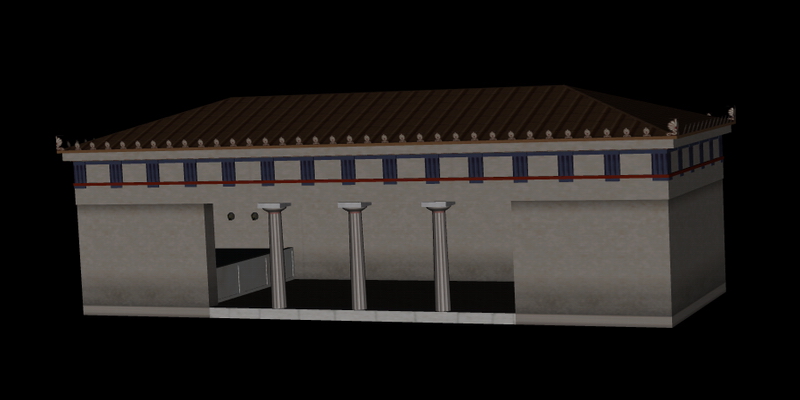While this is one of the best preserved buildings of the Agora’s south side, the digital reconstruction of the Southeast Fountain poses a series of difficulties, and the published drawings by the excavators have been deemed insufficient or even inaccurate in parts. The building was constructed during the Archaic period and is preserved until the Roman period. Thus, it is represented for all three of the periods represented (Classical, Hellenistic, Roman).
The design of its exterior poses no difficulties: it comprises three sections, a central room and two flanking spaces. Of its superstructure, however, nothing remains, and its identification as a fountain results from the existence of a pipe supplying water. We have accepted the suggestion, confirmed by the representations of fountains on Attic black figure vases from the Archaic period [e.g. the hydria in Μ. Τιβέριος, Ελληνικά Αγγεία (Αθήνα 1996), pp. 93, fig. 56], that water flowed in the side rooms from spouts placed on the wall, while we have followed the proposal of the excavators, according to which the side rooms were cisterns, delimited by a parapet.
For the superstructure there are two suggestions: the original hypothesis of the excavators, who have depicted a building of 3 Doric columns on its façade [as featured in the Agora maquette for the Archaic period see e.g. Μc Camp II, J., The Athenian Agora, A Short Guide to the Excavations, Excavations of the Athenian Agora, Picture Book no 16, American School of Classical Studies (Princeton 2003), p. 22, fig. 34]. The other view was formulated by L.C. Merit [‘Some Ionic Architectural Fragments from the Athenian Agora’, in Studies in Athenian Architecture, Sculpture and Topography presented to Homer A. Thompson (Hesperia Supplement XX, Princeton 1982), pp. 82-92, plates 12-13], and ascribes to the fountain two Archaic Ionic columns and three bases of Ionic columns of island marble, which definitely do not originate from the same building. This suggestion has not gained acceptance, and for this reason we preferred to use the first suggestion as a basis for the representation.
The extensive modifications of the 1st half of the 4th cent. BC do not alter its interior. Its form during the Roman period is unknown, when many other fountain structures were in still in use in the south part of the Agora; on the other hand, there is no indication that it was demolished. Therefore, we have retained the same representation for all the phases.
The excavators used to identify this as the Enneakrounos fountain described by Pausanias. A reconstruction, however, accommodating nine spouts is impossible [Mc Camp II, J.,
The Water Supply of Ancient Athens from 3000 to 86 BC, Dissertation Princeton University (Ann Arbor Microfilms 1978), pp. 73-94].

Southeast fountain, 3D representation

